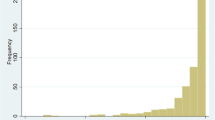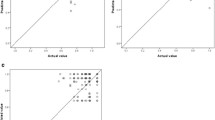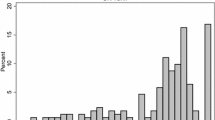Abstract
Objective
This study aimed to develop a mapping algorithm to evaluate the EQ-5D-5L according to the FACT-L when the EQ-5D-5L is not available.
Methods
EQ-5D-5L and FACT-L data were collected from patients with lung cancer in Departments of Thoracic Surgery, Medical Oncology, Radiation Oncology, Sichuan Cancer Hospital. We used the ordinary least squares model (OLS), Tobit model (Tobit), two-part model (TPM), beta mixture regression (BM), and censored least absolute deviation model (CLAD) to map the results of the FACT-L according to EQ-5D-5L scores. To establish these models, the total score, dimension scores, squared items, and interaction items were introduced. Performance metrics including Adjusted R2, root mean square error (RMSE), and mean absolute error (MAE) were used to select the optimized model.
Results
The model with the best mapping performance was the BM model (BETAMIX4) with the PWB (physical well-being) dimension, FWB (functional well-being) dimension, the squared term of the PWB dimension, and the squared term of the FWB dimension as covariates. The final prediction metrics were Adjusted R2 = 0.695, RMSE = 0.206, and MAE = 0.109. Fivefold cross-validation (CV) results also demonstrated that the BM model had the best mapping power.
Conclusions
This study developed an optimized mapping algorithm to predict the utility index from the FACT-L to the EQ-5D-5L, which provides an effective alternative reference for EQ-5D-5L estimation when the preference-based health utility values were unavailable.




Similar content being viewed by others
Data availability
The datasets generated and/or analyzed during the current study are available from the corresponding author upon reasonable request.
Abbreviations
- ARV:
-
Average ranking value
- CLAD:
-
Censored least absolute deviations
- CUA:
-
Cost-utility analysis
- CV:
-
Cross-validation
- EWB:
-
Emotional well-being
- FACT-L:
-
Functional Assessment of Cancer Therapy-Lung
- FWB:
-
Functional well-being
- HRQoL:
-
Health-related quality of life
- LCS:
-
Lung Cancer Subscale
- MAE:
-
Mean absolute error
- MID:
-
Minimally important difference
- OLS:
-
Ordinary least squares
- PWB:
-
Physical well-being
- QALY:
-
Quality-adjusted life year
- QoL:
-
Quality of life
- RMSE:
-
Root mean square error
- SWB:
-
Social/family well-being
- TPM:
-
Two-part model
References
Sung, H., Ferlay, J., Siegel, R. L., Laversanne, M., Soerjomataram, I., Jemal, A., & Bray, F. (2021). Global Cancer Statistics 2020: GLOBOCAN Estimates of Incidence and Mortality Worldwide for 36 Cancers in 185 Countries. CA: a cancer journal for clinicians, 71(3), 209–249. https://doi.org/10.3322/caac.21660
Xia, C., Dong, X., Li, H., Cao, M., Sun, D., He, S., Yang, F., Yan, X., Zhang, S., Li, N., & Chen, W. (2022). Cancer statistics in China and United States, 2022: profiles, trends, and determinants. Chinese medical journal, 135(5), 584–590. https://doi.org/10.1097/cm9.0000000000002108
Drummond, M. F., Sculpher, M. J., Claxton, K., Stoddart, G. L., & Torrance, G. W. (2015). Methods for the Economic Evaluation of Health Care Programmes. (4th ed.) Oxford University Press.
Goodwin, E., & Green, C. (2016). A Systematic Review of the Literature on the Development of Condition-Specific Preference-Based Measures of Health. Applied health economics and health policy, 14(2), 161–183.
Weldring, T., & Smith, S. M. (2013). Patient-Reported Outcomes (PROs) and Patient-Reported Outcome Measures (PROMs). Health services insights, 6, 61–68. https://doi.org/10.4137/hsi.S11093
Longworth, L., & Rowen, D. (2013). Mapping to obtain EQ-5D utility values for use in NICE health technology assessments. Value in Health, 16(1), 202–210.
Wailoo, A. J., Hernandez-Alava, M., Manca, A., Mejia, A., Ray, J., Crawford, B., Botteman, M., & Busschbach, J. (2017). Mapping to Estimate Health-State Utility from Non-Preference-Based Outcome Measures: An ISPOR Good Practices for Outcomes Research Task Force Report. Value in Health, 20(1), 18–27. https://doi.org/10.1016/j.jval.2016.11.006
Whitehead, S. J., & Ali, S. (2010). Health outcomes in economic evaluation: the QALY and utilities. British Medical Bulletin, 96, 5–21. https://doi.org/10.1093/bmb/ldq033
Khan, I., Morris, S., Pashayan, N., Matata, B., Bashir, Z., & Maguirre, J. (2016). Comparing the mapping between EQ-5D-5L, EQ-5D-3L and the EORTC-QLQ-C30 in non-small cell lung cancer patients. Health and Quality of Life Outcomes, 14, 60. https://doi.org/10.1186/s12955-016-0455-1
Cella, D. F., Bonomi, A. E., Lloyd, S. R., Tulsky, D. S., Kaplan, E., & Bonomi, P. (1995). Reliability and validity of the Functional Assessment of Cancer Therapy-Lung (FACT-L) quality of life instrument. Lung Cancer, 12(3), 199–220. https://doi.org/10.1016/0169-5002(95)00450-f
Dakin, H., Abel, L., Burns, R., & Yang, Y. (2018). Review and critical appraisal of studies mapping from quality of life or clinical measures to EQ-5D: an online database and application of the MAPS statement. Health and Quality of Life Outcomes, 16(1), 31. https://doi.org/10.1186/s12955-018-0857-3
Kind, P., & Macran, S. (2005). Eliciting social preference weights for Functional Assessment of Cancer Therapy-Lung health states. PharmacoEconomics, 23(11), 1143–1153. https://doi.org/10.2165/00019053-200523110-00006
Pickard, A. S., Ray, S., Ganguli, A., & Cella, D. (2012). Comparison of FACT- and EQ-5D-based utility scores in cancer. Value in health: The journal of the International Society for Pharmacoeconomics and Outcomes Research, 15(2), 305–311. https://doi.org/10.1016/j.jval.2011.11.029
Xi-Jing, F. U., Liang, M. H., Sun, M., Gao, P., Kong, C., & Zhu, W. T. (2014). Analysis on applying mapping method in measuring health utility values. Chinese Health Economics, 33(10), 32–35.
Zhu, J., Yan, X. X., Liu, C. C., Wang, H., Wang, L., Cao, S. M., Liao, X. Z., Xi, Y. F., Ji, Y., Lei, L., Xiao, H. F., Guan, H. J., Wei, W. Q., Dai, M., Chen, W., & Shi, J. F. (2021). Comparing EQ-5D-3L and EQ-5D-5L performance in common cancers: suggestions for instrument choosing. Quality of Life Research, 30(3), 841–854. https://doi.org/10.1007/s11136-020-02636-w
Lamu, A. N., Chen, G., Gamst-Klaussen, T., & Olsen, J. A. (2018). Do country-specific preference weights matter in the choice of mapping algorithms? The case of mapping the Diabetes-39 onto eight country-specific EQ-5D-5L value sets. Quality of Life Research, 27(7), 1801–1814. https://doi.org/10.1007/s11136-018-1840-5
Petrou, S., Rivero-Arias, O., Dakin, H., Longworth, L., Oppe, M., Froud, R., & Gray, A. (2015). The MAPS Reporting Statement for Studies Mapping onto Generic Preference-Based Outcome Measures: Explanation and Elaboration. PharmacoEconomics, 33(10), 993–1011. https://doi.org/10.1007/s40273-015-0312-9
Wan, C., Zhang, C., Cai, L., Tu, X., Feng, C., Luo, J., & Zhang, X. (2007). Psychometric properties of the Chinese version of the FACT-L for measuring quality of life in patients with lung cancer. Lung Cancer, 56(3), 415–421. https://doi.org/10.1016/j.lungcan.2007.01.004
Chang, W. P., Lin, Y. K., & Lin, C. C. (2019). Psychometric evaluation of the Taiwanese version of the functional assessment of cancer therapy: a questionnaire for patients with lung cancer. International Journal for Quality in Health Care, 31(7), 513–518. https://doi.org/10.1093/intqhc/mzy201
Rabin, R., Oemar, M., & Oppe, M. (2011). EQ-5D-5L User Guide—Basic information on how to use the EQ-5D-5L instrument.
Luo, N., Liu, G., Li, M., Guan, H., Jin, X., & Rand-Hendriksen, K. (2017). Estimating an EQ-5D-5L Value Set for China. Value in Health, 20(4), 662–669. https://doi.org/10.1016/j.jval.2016.11.016
Gansterer, W. N., Niederbrucker, G., Straková, H., & Schulze Grotthoff, S. (2013). Scalable and fault tolerant orthogonalization based on randomized distributed data aggregation. Journal of Computational Science, 4(6), 480–488. https://doi.org/10.1016/j.jocs.2013.01.006
Stolk, E., Ludwig, K., Rand, K., van Hout, B., & Ramos-Goñi, J. M. (2019). Overview, Update, and Lessons Learned From the International EQ-5D-5L Valuation Work: Version 2 of the EQ-5D-5L Valuation Protocol. Value in Health, 22(1), 23–30. https://doi.org/10.1016/j.jval.2018.05.010
Meregaglia, M., Whittal, A., Nicod, E., & Drummond, M. (2020). ‘Mapping’ Health State Utility Values from Non-preference-Based Measures: A Systematic Literature Review in Rare Diseases. PharmacoEconomics, 38(6), 557–574. https://doi.org/10.1007/s40273-020-00897-4
Mukuria, C., Rowen, D., Harnan, S., Rawdin, A., Wong, R., Ara, R., & Brazier, J. (2019). An Updated Systematic Review of Studies Mapping (or Cross-Walking) Measures of Health-Related Quality of Life to Generic Preference-Based Measures to Generate Utility Values. Applied Health Economics and Health Policy, 17(3), 295–313. https://doi.org/10.1007/s40258-019-00467-6
Kent, S., Gray, A., Schlackow, I., Jenkinson, C., & McIntosh, E. (2015). Mapping from the Parkinson's Disease Questionnaire PDQ-39 to the Generic EuroQol EQ-5D-3L: The Value of Mixture Models. Medical Decision Making, 35(7), 902–911. https://doi.org/10.1177/0272989x15584921
Powell, J. (1984). Least absolute deviations estimation for the censored regression model. Journal of Econometrics, 25(3), 303–325.
Dow, W. H., & Norton, E. C. (2003). Choosing between and interpreting the Heckit and two-part models for corner solutions. Health Services and Outcomes Research Methodology, 4(1), 5–18.
Dziak, J. J., & Henry, K. L. (2017). Two-part predictors in regression models. Multivariate Behavioral Research, 52(5), 551–561. https://doi.org/10.1080/00273171.2017.1333404
Badia, X., Trainer, P., Biermasz, N. R., Tiemensma, J., Carreño, A., Roset, M., Forsythe, A., & Webb, S. M. (2018). Mapping AcroQoL scores to EQ-5D to obtain utility values for patients with acromegaly. Journal of Medical Economics, 21(4), 382–389. https://doi.org/10.1080/13696998.2017.1419960
Brazier, J. E., Yang, Y., Tsuchiya, A., & Rowen, D. L. (2010). A review of studies mapping (or cross walking) non-preference based measures of health to generic preference-based measures. The European Journal of Health Economics, 11(2), 215–225. https://doi.org/10.1007/s10198-009-0168-z
Gray, L. A., & Alava, M. H. (2018). A Command for Fitting Mixture Regression Models for Bounded Dependent Variables Using the Beta Distribution. The Stata Journal, 18(1), 51–75. https://doi.org/10.1177/1536867X1801800105
Yang, Q., Yu, X. X., Zhang, W., & Li, H. (2019). Mapping function from FACT-B to EQ-5D-5 L using multiple modelling approaches: data from breast cancer patients in China. Health and Quality of Life Outcomes, 17(1), 153. https://doi.org/10.1186/s12955-019-1224-8
Wong, C. K. H., Cheung, P. W. H., Samartzis, D., Luk, K. D., Cheung, K. M. C., Lam, C. L. K., & Cheung, J. P. Y. (2017). Mapping the SRS-22r questionnaire onto the EQ-5D-5L utility score in patients with adolescent idiopathic scoliosis. PloS One, 12(4), e0175847. https://doi.org/10.1371/journal.pone.0175847
Bilbao, A., Martín-Fernández, J., García-Pérez, L., Arenaza, J. C., Ariza-Cardiel, G., Ramallo-Fariña, Y., & Ansola, L. (2020). Mapping WOMAC onto the EQ-5D-5L utility index in patients with hip or knee osteoarthritis. Value in Health, 23(3), 379–387. https://doi.org/10.1016/j.jval.2019.09.2755
Cheung, Y. B., Luo, N., Ng, R., & Lee, C. F. (2014). Mapping the functional assessment of cancer therapy-breast (FACT-B) to the 5-level EuroQoL Group’s 5-dimension questionnaire (EQ-5D-5L) utility index in a multi-ethnic Asian population. Health and Quality of Life Outcomes, 12, 180. https://doi.org/10.1186/s12955-014-0180-6
McClure, N. S., Sayah, F. A., Xie, F., Luo, N., & Johnson, J. A. (2017). Instrument-defined estimates of the minimally important difference for EQ-5D-5L index scores. Value in Health, 20(4), 644–650. https://doi.org/10.1016/j.jval.2016.11.015
Yang, F., Devlin, N., & Luo, N. (2019). Impact of mapped EQ-5D utilities on cost-effectiveness analysis: In the case of dialysis treatments. European Journal of Health Economics, 20(1), 99–105. https://doi.org/10.1007/s10198-018-0987-x
Hagiwara, Y., Kawahara, T., & Shiroiwa, T. (2020). What is a valid mapping algorithm in cost-utility analyses? A response from a missing data perspective. Value in Health, 23(9), 1218–1224. https://doi.org/10.1016/j.jval.2020.03.020
Gray, L. A., Hernández Alava, M., & Wailoo, A. J. (2018). Development of methods for the mapping of utilities using mixture models: Mapping the AQLQ-S to the EQ-5D-5L and the HUI3 in patients with asthma. Value in Health, 21(6), 748–757. https://doi.org/10.1016/j.jval.2017.09.017
Ali, F. M., Kay, R., Finlay, A. Y., Piguet, V., Kupfer, J., Dalgard, F., & Salek, M. S. (2017). Mapping of the DLQI scores to EQ-5D utility values using ordinal logistic regression. Quality of Life Research, 26(11), 3025–3034. https://doi.org/10.1007/s11136-017-1607-4
Ameri, H., Yousefi, M., Yaseri, M., Nahvijou, A., Arab, M., & Akbari Sari, A. (2019). Mapping the cancer-specific QLQ-C30 onto the generic EQ-5D-5L and SF-6D in colorectal cancer patients. Expert Review of Pharmacoeconomics and Outcomes Research, 19(1), 89–96. https://doi.org/10.1080/14737167.2018.1517046
Longworth, L., & Rowen, D. (2013). Mapping to obtain EQ-5D utility values for use in NICE health technology assessments. Value in Health, 16(1), 202–210. https://doi.org/10.1016/j.jval.2012.10.010
Chen, P., Wan, G., & Zhu, B. (2021). Incidence and risk factors of symptomatic thrombosis related to peripherally inserted central catheter in patients with lung cancer. Journal of Advanced Nursing, 77(3), 1284–1292. https://doi.org/10.1111/jan.14666
Sauerland, S., Weiner, S., Dolezalova, K., Angrisani, L., Noguera, C. M., García-Caballero, M., Rupprecht, F., & Immenroth, M. (2009). Mapping utility scores from a disease-specific quality-of-life measure in bariatric surgery patients. Value in Health, 12(2), 364–370. https://doi.org/10.1111/j.1524-4733.2008.00442.x
Acknowledgements
The authors thank all participants for their time and effort.
Funding
This study was supported by Foundation of Department of Science and Technology of Sichuan Province, China, Grant Number: 2020YFS0397, and Sichuan Province Clinical Key Specialty Construction Project.
Author information
Authors and Affiliations
Contributions
QY conceived and designed this study; LLJ, XL, and DYH participated in the acquisition of the data; LLJ analyzed the data, interpreted the results, and wrote the first draft of the manuscript; and HZ supervised the statistical analysis, gave feedback on the manuscript, and revised it critically for important intellectual content. All authors have read and approved the final version of the manuscript.
Corresponding author
Ethics declarations
Conflict of interest
The authors declare no conflicts of interest.
Ethical approval
The study has been approved by the Ethics Committee of Sichuan Cancer Hospital (Reference No. SCCHEC-02-2020-042). The study followed the principle of the Declaration of Helsinki.
Informed consent
Informed consent was obtained from all individual participants included in the study.
Additional information
Publisher's Note
Springer Nature remains neutral with regard to jurisdictional claims in published maps and institutional affiliations.
Supplementary Information
Below is the link to the electronic supplementary material.
Rights and permissions
Springer Nature or its licensor (e.g. a society or other partner) holds exclusive rights to this article under a publishing agreement with the author(s) or other rightsholder(s); author self-archiving of the accepted manuscript version of this article is solely governed by the terms of such publishing agreement and applicable law.
About this article
Cite this article
Jiang, L., Zhou, H., Yang, Q. et al. Development of algorithms to estimate the EQ-5D-5L from the FACT-L in patients with lung cancer: a mapping study. Qual Life Res 33, 805–816 (2024). https://doi.org/10.1007/s11136-023-03567-y
Accepted:
Published:
Issue Date:
DOI: https://doi.org/10.1007/s11136-023-03567-y




